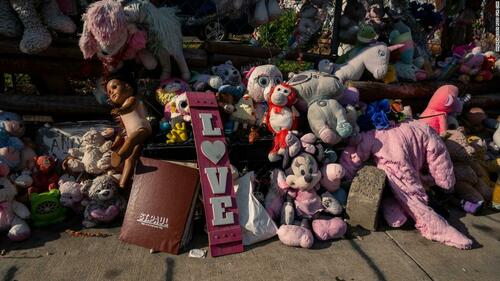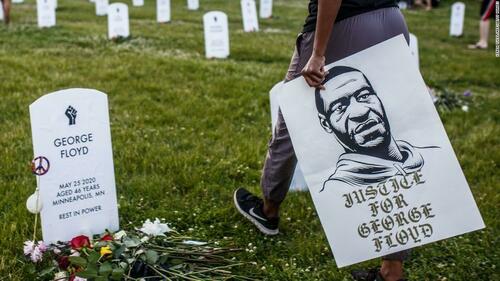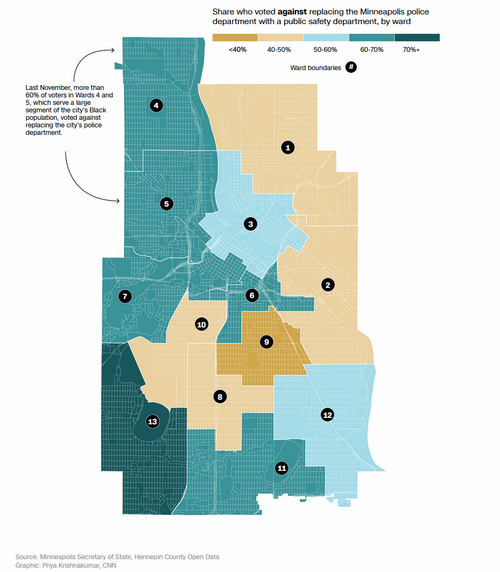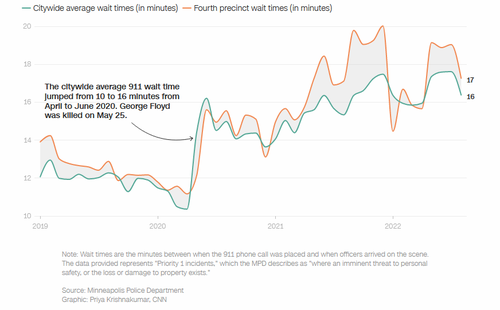
In the mid-1990s, the murder rate was so high in Minneapolis that it earned the nickname, "Murderapolis."
Now, more than two years after the Democrat stronghold turned into ground zero for the 'defund the police' movement after the murder of George Floyd, Murderopolis is back.
In a kind of Newtonian response, the city became the epicenter of the culturally seismic "Defund the Police" movement. But that progressive local effort fizzled with a decisive referendum last November.
Now, with its police department under investigation by the Department of Justice, the city of 425,000 is trying to find a way forward amid a period of heightened crime that began shortly after Floyd's death. -CNN
In 2020, murders jumped from 46 to nearly 80. In 2021, 93 people were killed in the city. This year, homicides are on track to surpass 2020.
"The criminals were celebrating. They were getting rich" after police withdrew from violent neighborhoods in the wake of Floyd's killing, said longtime resident, KG Wilson. "They were selling drugs openly."
Wilson's 6-year-old granddaughter was killed in May of 2021 after getting caught in the crossfire of a shootout in north Minneapolis.
Others are blaming the pandemic.
"It unsettled settled trajectories," said former federal prosecutor, Mark Osler, who now teaches at St. Thomas School of Law in Minneapolis. "Kids who were going to school, who would have graduated but drifted off because there is no school — we're seeing a lot of the violent crime is by juveniles."
After the left demonized cops following Floyd's murder, the Minneapolis PD headcount dropped from 900 in early 2020 to around 560 in August - a loss of more than 1/3 of the force.
The hate was so strong that a 2021 ballot measure which would have replaced the Minneapolis PD with a new "public health-oriented" Department of Public Safety, barely failed - with 56% of voters rejecting it (61% in north Minneapolis).
Then, the city council got wise as crime skyrocketed - dealing a final blow to the "defund" movement with a vote to re-fund the police by reversing a cut they'd made the prior year. Mayor Jacob Frey, meanwhile, has proposed beefing up the police budget for the next two fiscal years.
Feeling of lawlessness
According to the report, some 60% of police calls for shots fired have come from the north side, despite it making up just 15% of the population. Young men are openly selling drugs in public during the day, such as a gas station on Broadway ave. dubbed the "murder station" due to all the fatal shootings.
"You pull up to get gas -- they try to sell you drugs," said Paul Johnson, 56. "And not just three or four, but it's a bulk of people."
Johnson's friend, Brian Bogan, said he moved from north Minneapolis to relatively safer St. Paul, because he didn't want his kids growing up in an area where you don't know if "it's fireworks or gunshots."
911 wait times have jumped
After Floyd's death average 911 response times from from 10 or 11 minutes in May of 2020, to 14 minutes later in the year - jumping in 2021 to more than 17 minutes in the north side's fourth precinct, where they remain.
Some nights are so busy that the dispatchers are directed to hold all non-priority-1 calls citywide; these would include reports of property damage, suspicious persons or theft. That happened during a frenetic five-hour stretch on the night of September 8, when officers responded to multiple shootings and calls for shots fired — many of them in north Minneapolis; one near the "murder station" — that left two dead and seven wounded. -CNN
Police officials have characterized the slower response times as an "expected byproduct of a depleted force that has witnessed an overwhelming wave of retirements, resignations and disability leaves" due to post-traumatic stress.
"There's really been a very fundamental challenge to our sense of purpose in law enforcement," said interim Minneapolis Police Chief Amelia Huffman. "(Minneapolis) is the eye of the storm. So all of those challenges and the pressure is magnified, you know, a hundred fold -- a thousand fold."
In the mid-1990s, the murder rate was so high in Minneapolis that it earned the nickname, “Murderapolis.”
Now, more than two years after the Democrat stronghold turned into ground zero for the ‘defund the police’ movement after the murder of George Floyd, Murderopolis is back.
In a kind of Newtonian response, the city became the epicenter of the culturally seismic “Defund the Police” movement. But that progressive local effort fizzled with a decisive referendum last November.
Now, with its police department under investigation by the Department of Justice, the city of 425,000 is trying to find a way forward amid a period of heightened crime that began shortly after Floyd’s death. –CNN
In 2020, murders jumped from 46 to nearly 80. In 2021, 93 people were killed in the city. This year, homicides are on track to surpass 2020.
“The criminals were celebrating. They were getting rich” after police withdrew from violent neighborhoods in the wake of Floyd’s killing, said longtime resident, KG Wilson. “They were selling drugs openly.”
Wilson’s 6-year-old granddaughter was killed in May of 2021 after getting caught in the crossfire of a shootout in north Minneapolis.
Others are blaming the pandemic.
“It unsettled settled trajectories,” said former federal prosecutor, Mark Osler, who now teaches at St. Thomas School of Law in Minneapolis. “Kids who were going to school, who would have graduated but drifted off because there is no school — we’re seeing a lot of the violent crime is by juveniles.”
After the left demonized cops following Floyd’s murder, the Minneapolis PD headcount dropped from 900 in early 2020 to around 560 in August – a loss of more than 1/3 of the force.
The hate was so strong that a 2021 ballot measure which would have replaced the Minneapolis PD with a new “public health-oriented” Department of Public Safety, barely failed – with 56% of voters rejecting it (61% in north Minneapolis).
Then, the city council got wise as crime skyrocketed – dealing a final blow to the “defund” movement with a vote to re-fund the police by reversing a cut they’d made the prior year. Mayor Jacob Frey, meanwhile, has proposed beefing up the police budget for the next two fiscal years.
Feeling of lawlessness
According to the report, some 60% of police calls for shots fired have come from the north side, despite it making up just 15% of the population. Young men are openly selling drugs in public during the day, such as a gas station on Broadway ave. dubbed the “murder station” due to all the fatal shootings.
“You pull up to get gas — they try to sell you drugs,” said Paul Johnson, 56. “And not just three or four, but it’s a bulk of people.”
Johnson’s friend, Brian Bogan, said he moved from north Minneapolis to relatively safer St. Paul, because he didn’t want his kids growing up in an area where you don’t know if “it’s fireworks or gunshots.”
911 wait times have jumped
After Floyd’s death average 911 response times from from 10 or 11 minutes in May of 2020, to 14 minutes later in the year – jumping in 2021 to more than 17 minutes in the north side’s fourth precinct, where they remain.
Some nights are so busy that the dispatchers are directed to hold all non-priority-1 calls citywide; these would include reports of property damage, suspicious persons or theft. That happened during a frenetic five-hour stretch on the night of September 8, when officers responded to multiple shootings and calls for shots fired — many of them in north Minneapolis; one near the “murder station” — that left two dead and seven wounded. -CNN
Things have gotten so bad that the Minneapolis PD has flatly refused to respond to certain crimes in a timely manner – such as thefts and stolen goods. According to the police, hostility towards officers has compelled them to take a slower approach in certain parts of town.
Police officials have characterized the slower response times as an “expected byproduct of a depleted force that has witnessed an overwhelming wave of retirements, resignations and disability leaves” due to post-traumatic stress.
“There’s really been a very fundamental challenge to our sense of purpose in law enforcement,” said interim Minneapolis Police Chief Amelia Huffman. “(Minneapolis) is the eye of the storm. So all of those challenges and the pressure is magnified, you know, a hundred fold — a thousand fold.”








